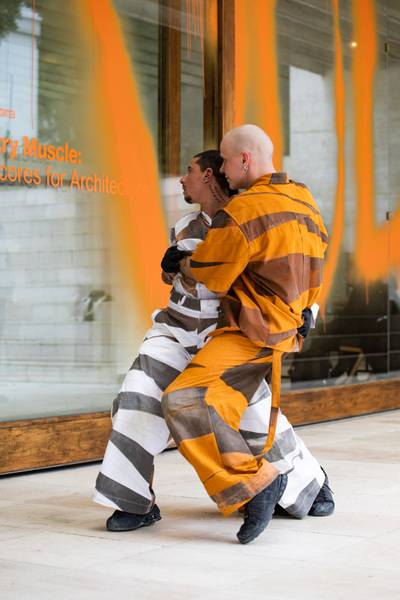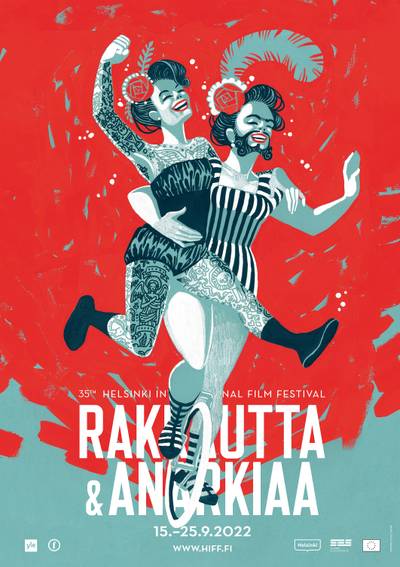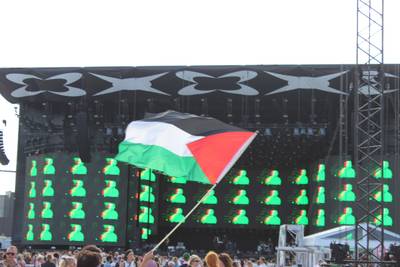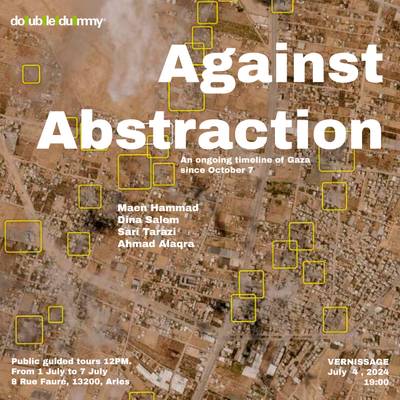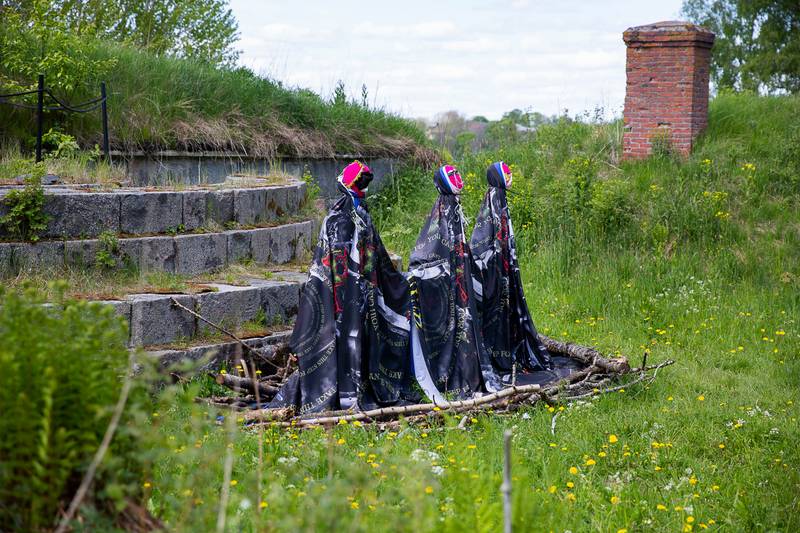

Danielle Brathwaite-Shirley: Thou Shall Not Assume (Sinun ei pidä olettaman), 2023. © HAM/Helsinki Biennial/Sonja Hyytiäinen
Joonas Pulkkinen is a freelance art worker, curator, critic, and journalist. He has a long interest in biennials as a sites for site-specific art and their role in exploring questions of globality.
A biennial is a complex and spectacular format for exhibiting art. Conversely, it serves as a forum where curators and artists attempt to engage in a broader dialogue within the web of… well, biennials, which appear to be a more structured social construction within the “art world.” Why should one still pay attention to the Helsinki Biennial 2023 (HB23) even though it has already concluded, and what could a biennial represent in the context of Helsinki or, more broadly, within the Baltic Sea region?
This text focuses on topics related to HB23’s thematic questions and experiments mediated by curator Joasia Krysa in the biennial and her partly experimental approach with curatorial collaborators. These are questions about how the mediation of art is inextricably linked with the possibility of political and environmental agency and awareness. They delve into the political and ecological environment of the Baltic Sea, its historical significance as potential material within the context of the Helsinki Biennial, and the kinds of geopolitical and historical questions that biennials might confront in the Baltic Sea area.
To give perspective related to HB23’s critique and new ways of understanding the Helsinki Biennial in a global community of biennials, the aforementioned thematic question and the biennial will be evaluated in the context of “locality” within a broader understanding of the Baltic Sea area—an approach based on how the past two editions of the Helsinki Biennial have been connected to a maritime context and in relation to the Baltic Sea’s region, currently undergoing new geopolitical transformations due to the Russo-Ukrainian War.
Additionally, the questions and topics presented in this text relate to the concept and process-oriented approach of Krysa and the curatorial collaborators, which have not been evaluated in the critiques and writings of HB23.
Re-Thinking the Biennial Format and Preparing to Act
The objective of the Helsinki Biennial 2023 was to reflect on the eco-diversity of Vallisaari and point to broader geopolitical implications (Krysa 2023a, pp. 8–9). Thematically, the concept “new directions may emerge,” a quote borrowed from anthropologist Anna Lowenhaupt Tsing, was grounded in three key concepts: contamination, regeneration, and agency. From the perspective of a regular visitor, a biennial tourist, or, as we later notice, even an art critic, these are ambiguous and enigmatic words, requiring thinking about their relation to each other and why.
The curator of HB23, Joasia Krysa, posed open-ended questions: ‘How might contamination be a force for positive change? How can we use biennials for the wider regeneration of things? How might agency extend beyond humans to other nonhuman entities and assemblages, including artificial intelligences? How might these threads be channeled into rethinking the ways that practices and future worlds might be conceived?” (Krysa 2023b, 17.)
Krysa underscored in her curatorial statement the geopolitical specificity of the biennial, emphasizing its connections in various directions: the proximity of Estonia, whose coastline is also visible from Vallisaari in favorable weather conditions; the Baltic Sea serving as a route to Western parts of Europe; Sápmi in the north; and the ethical and cultural diversity in Helsinki. From this location, the aim was to initiate a process to address contemporary problems that often appear insurmountable – the ecological crisis, political conflicts, and the consequential effects of technological development. The biennial seeks answers to humanity’s harmful actions, not necessarily solutions, both possible and impossible (ibid. 15–16).
According to Krysa, contamination, regeneration, and agency were not mere themes but intersecting directions that brought together ways of cooperation and topics that were not tied to a specific site or direction (ibid. 16). The open-ended questions were rooted in the idea of potential spaces and considered the geopolitical reality of Helsinki and other places on the level of action or agency (ibid. 16–17).
Contamination aimed to draw attention to the pollution of the Baltic Sea and the Vallisaari island’s ecology (ibid. 17). Regeneration’s goal was to explore how tourism and investments, where biennials are usually based, could offer possibilities for environmental regeneration (ibid. 20). Agency served as a research tool for the biennial, exploring how human life, the environment, and technology could evolve together with unprecedented outcomes, without conflicting with one another (ibid. 21–22).
“New directions may emerge”, and while there are already perspectives on this planet – geopolitics and the environment – we often fail to consider, notice, or explore seriously. Nevertheless, the Helsinki Biennial has the necessary potential, which HB23 managed to bring forth and open up some of those topics that should continue, at least in the Finnish context.
It is not merely a matter of fashion, quality, or the visual appeal of the biennial; it is also about the broader relevance of biennials and their overarching purpose. By relevance, I speak mainly about the audiences of the biennial. Was the biennial’s goal to increase understanding of contamination, regeneration, and agency and feed new forms of activity? Or was the biennial directed more toward professionals and experts working on multidisciplinary practices of art and science?
I lean on the idea that there is no reason to overlook or underestimate the audience’s knowledge. HB23 still leads me to consider the differences between the “audience” and the “professional”. I think the biennial should aim to achieve both targets to work conceptually – birth a new kind of action and lead us to think of the biennial as a format for exhibiting art in new ways.
It is not merely a matter of fashion, quality, or the visual appeal of the biennial; it is also about the broader relevance of biennials and their overarching purpose. By relevance, I speak mainly about the audiences of the biennial. Was the biennial’s goal to increase understanding of contamination, regeneration, and agency and feed new forms of activity? Or was the biennial directed more toward professionals and experts working on multidisciplinary practices of art and science?
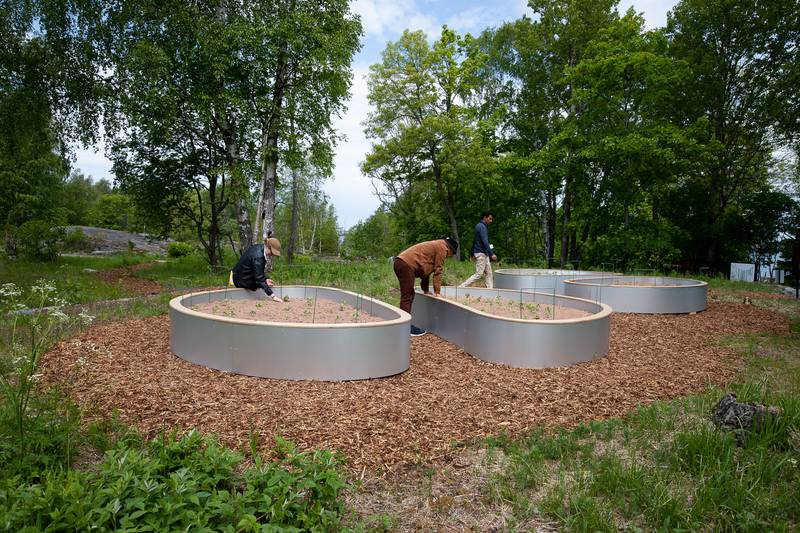

PHOSfate: PHOSfate, 2023. © HAM/Helsinki Biennial/Kirsi Halkola
Summary of the Critique – Jargon vs. Realism
In contrast to the first edition of the biennial, HB23 fell short of the visitor goal set for the exhibition. Compared to the inaugural edition, HB23 attracted nearly three times fewer visitors at its main venue, Vallisaari island (Frilander, 2023). According to HAM Helsinki Art Museum, they still managed to reach their other goals.
HB23 received significant criticism for the increased cost of ferry tickets, priced at €20—twice the rate compared to the first edition in 2021 (Herlin, 2023). Helsingin Uutiset reported in August that entrepreneurs on Vallisaari also suffered due to the higher ferry costs and fewer visitors. The article also raised the possibility of criticism earlier in June in Helsingin Sanomat as one potential reason for the decline in visitors (Rämö, 2023).
This reasoning might not be entirely misplaced. Harri Mäcklin and Sanna Lipponen discussed their disappointment with the biennial in a dialogue critique in Helsingin Sanomat. Mäcklin described the biennial as “amazingly poor” and felt that the artworks had overshadowed Vallisaari’s natural environment. He had hoped for a more daring integration of the environment and island sites and expressed disappointment regarding the quantity of works, size, and lack of inspiration. Mäcklin believed that a biennial should have international validity, and in his view, Adrián Villar Rojas’s series of site-specific sculptures did not represent this validity.
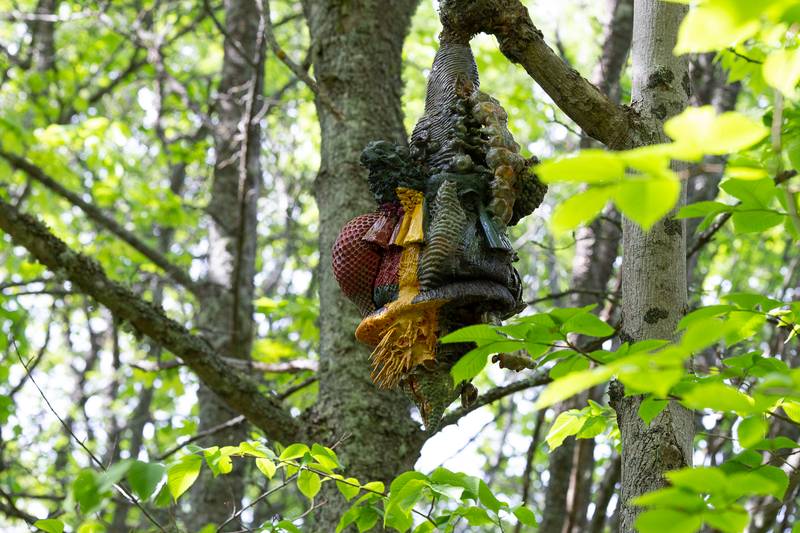

Adrián Villar Rojas, from the series The End of Imagination, 2023 © HAM/Helsinki Biennial/Viljami Annanolli
Paradoxically, in the same dialogue, Lipponen argued that in the context of the biennial, a more restrained setting could also be intimate and low-key in a positive manner. Lipponen observed that large biennials and mega-scale exhibitions often demand “Instagrammable megalomaniac works,” and she saw HB23 as having the potential to challenge this trend.
It is worth noting that there were fewer artworks in HB23, which led to more walking. There were fewer video and audio installations and more works based on augmented reality or requiring a platform or digital device for participation. In the picturesque setting of Vallisaari and the Helsinki archipelago, it felt somewhat incongruous to be engrossed in a mobile device amid the island’s natural beauty.
Maaria Ylikangas has already summarized the differences between Mäcklin and Lipponen’s dialogue critique and the not-so-flattering critique by Helen Korpak. In her text, Ylikangas primarily concentrated on differentiating between traditional art critique and dialogue format critique. Nevertheless, she encapsulated the core message under the main title, “Sometimes the Best Thing Is Ice Cream” (Ylikangas, 2023).
Helen Korpak characterized the Helsinki Biennial as an “escapist dreamworld” saturated with “techno-new age mumbo-jumbo.” Korpak called for “realistic visions” rather than abstract directions and concrete alternatives to nationalist and capitalistic tendencies (Korpak, 2023). Berlin-based freelance journalist and curator Adela Lovric claimed the value of HB23 “lies in proposing and practicing ways toward overcoming issues on multiple scales, from microscopic to planetary” (Lovric, 2023).
There were also representations based on the concrete state of capitalism and trans-national dependencies. Green Gold (2023) AR piece by Ahmed Al-Nawas and Minna Henriksson, an artwork experienced on a smart device while observing a timber raft pulling towards Kustaanmiekka in Suomenlinna, was not perhaps the best example of how augmented reality can visually be mind-blowing in the context of contemporary art. Still, it was conceptually and politically significant in the biennial context in general. Firstly, the work raised a critical deconstruction of national identity in the biennial context, focused critically on forestry, and emphasized the question of Finland’s dependency on Russian import timber.
Even though I share Korpak’s reminder of realism in some way, it is not so much a question of realistic visions that are needed but also describing the current conditions and past that are necessary. Being forthright about what is happening, political or ecological, is sometimes an intentful beginning.
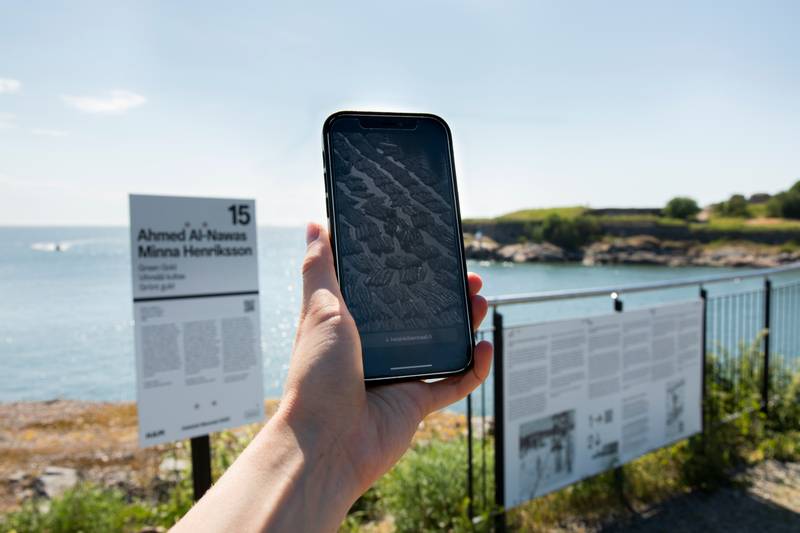

Ahmed Al-Nawas & Minna Henriksson: Green Gold, 2023. © HAM/Helsinki Biennial/Sonja Hyytiäinen
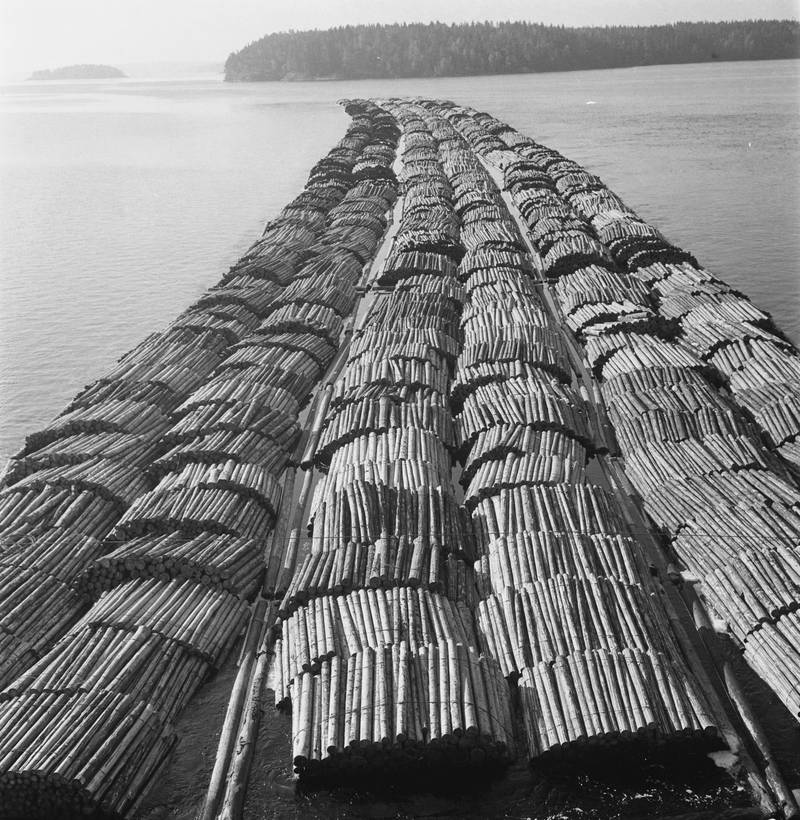

From the collection of The Finnish Heritage Agency, Teuvo Kanerva, 1960–1969
Sidenote or Interlude
Assessing its potential or what it could be is a peculiar way to critique a biennial, and I am not alone in sharing this perspective. It seems that those critiquing the HB23, whether journalists or commentators of the Helsinki “art scene” want it to either fail or succeed based on peculiar criteria like the quality of the works, the number of the works, the scale of the works and whether the biennial internationally relevant. Did the biennial truly manage to address the specificity of its site or its geopolitical location? Could be a more useful question to ask.
As I see it, it is challenging to determine how directly biennials should comment on the actual tensions and conflicts surrounding them. I concur that, in general, it is a difficult issue from the inclusivity of art perspective. Can an exhibition generally demand that visitors have a smartphone, as Korpak suggests?
Suppose our reality is increasingly built on different layers of realities and surfaces. Why not consider it from the perspective of SMART technology and its unavoidable presence in our daily lives? I do not find it surprising that art experiments explore audience experience in this manner because I believe art inherently possesses an experimental attitude. Contemporary art often engages with technological developments as part of its experimentation. Also, this is not a new concept or approach in the Finnish exhibition context. For instance, ARS17 (2018) at Kiasma was a major exhibition of international contemporary art on the theme of the digital revolution and how the Internet and digitalization have influenced the practice of art.
Of the artworks presented at Vallisaari during HB23, six required a smart device, which is a significant number in percentage terms, considering that the Biennial featured 29 artists and collectives, including performances. The first edition had 41 artists, collectives and working groups.
Smart devices and technological platforms offer alternative means for experiencing art. Perhaps one’s smartphone is not the best interface for this, as Korpak stated. How efficiently these applications or implementations’ functions function is an entirely different matter. It also raises questions about how biennials should be experienced. You do not have to see everything, even if there are not many artworks, because the exhibition experience should not be based solely on providing a comprehensive experience. I don’t believe in the ideal way of experiencing the biennial as a form of exhibiting art. Biennials could be based more on the possibilities of different ways of exploring or processuality like HB23 did.
To examine the pros and cons of HB23 to gain a better thematic understanding of HB23 and evaluate the directions it aimed to explore, I assess the biennial in three aspects that the critique so far has not paid much attention to, namely, ‘Mediating and Agency’, ‘The Same Sea’, and ‘Localities and Geopolitics’.
Mediating and Agency
Krysa has previously posed the question: Can curating be conceived and characterized by participation, interactivity, and feedback as “necessary elements in performing the curatorial functions of selecting and organising diverse materials (material objects, or data, or media, ideas, concepts) in particular ways to produce meaning?” (Krysa, 2013). These are also the questions that HB23 aimed to address thematically. On the other hand, I urge us to think of curating and curatorial processes being distinguished from the operational aspects of an exhibition, even though these may fall under the umbrella of “curatorial practices.”
While attempting to explore new directions, even in a technological sense, and expanding our ways of observing and experiencing reality, it does not necessarily imply the cybernetization of the exhibition (compare Mey 2023, pp. 35–37; Krysa 2013). The possibility of cybernetization in the context of a biennial would be an entirely different topic, and it is irrelevant to this text. However, the problem seems to be somewhat described above—it requires, according to the father of cybernetics, Norbert Wiener, “the feedback which enables self-regulation” (Mey,´2023, p. 37). According to Wiener, feedback should change our behavior:
“This last function, - -, is called feedback, the property of being able to adjust future conduct by past performance. Feedback may be as simple as that of the common reflex, or it may be a higher order feedback, in which past experience is used not only to regulate specific movements, but also whole policies of behavior. Such a policy-feedback may, and often does, appear to be what we know under one aspect as a conditioned reflex, and under another as learning.” (Wiener 1989, p. 33).
For an exhibition to be truly cybernetic, one would expect feedback, which is why I have reservations about the possibility of the exhibition’s potential for self-organized processes. I am not so convinced of how biennials can change our agency. At the same time, I sympathise with Krysa’s ideas of extending curating and care in this context as an ongoing interest of her work: “- -reconfiguring the traditional understanding of the term curating as caring for objects or collections - and extend to caring for wider social relations across humans and machines across complex networks” (Krysa, 2013). Questions related to knowledge, worldviews, history, and the relationship between art and science have been raised in the critiques I have cited, and these questions do not have much to do with the qualitative understanding of the biennial.
One argument for why we need biennials is because, as a format, they have the potential to showcase a plurality of different consciousnesses and orientations. Such showcasing is more fluid for biennials than for museums because museums are physical places with a mission to preserve objects based on more or less nationalistic or institutional agendas.
Biennials often receive the critique that biennial art is “often monumentally scaled, elaborately produced, rapidly consumable and photogenic (now read as Instagrammable), veering towards the spectacular” (Niemojewski, 2021). In HB23, I sensed a will to pay attention to the topics.
For the second edition of the Helsinki Biennial, Krysa invited five arts, research, and technological entities for curatorial collaboration. Collaborators were the Museum of Impossible Forms, TBA21-Academy, Critical Environmental Data, ViCCA at Aalto Arts, and A.I. Entity, whose work was supposed to formulate new and unexpected groupings in the Helsinki Art Museum’s collection. I am not aware of these results or whether this work continues.
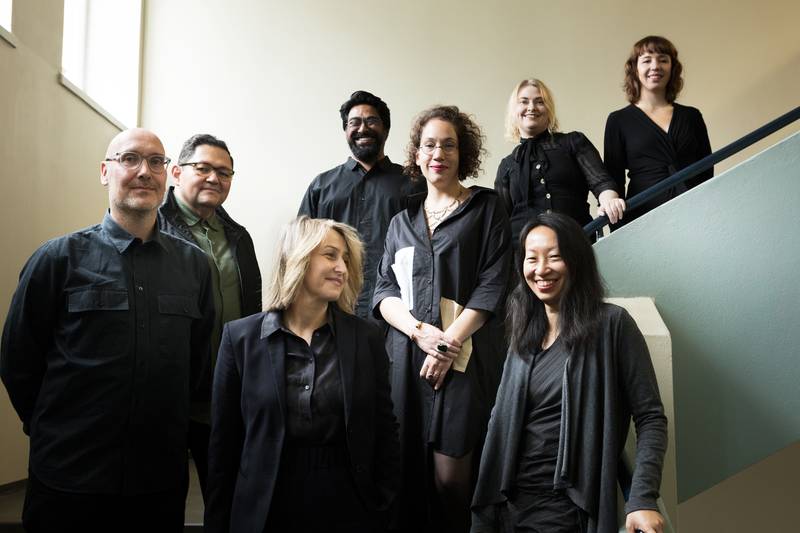

Curatorial collaborators of Helsinki Biennial 2023, Photo: Verna Kovanen
Critical Environmental Data (Jussi Parikka, May Ee Wong & Paolo Patelli) is a transdisciplinary research group at Aarhus University in Denmark. Although their practice is not located in Helsinki, the work of “The Environmental Audiotour” was an example of how to mediate essential and relevant local aspects for international guests. In the form of a five-episode podcast, they represented and mediated aspects of the local environment and changing urban space. They explored topics such as weather forecasting, the impact of ships on the modification of the islands in the Helsinki archipelago, and strategies for preserving energy resources in the future.
For me, perhaps the most influential work of the whole biennial was not located in Vallisaari. I think Golden Snail Opera, a collaboration between anthropologists Yen-Ling Tsai and Anna Lowenhaupt Tsing, filmmaker Isabelle Carbonell, and farmer and translator Joelle Chevrier, performed at the Central Library Oodi was perhaps the key to thinking about HB23’s concept in a new light.
Golden Snail Opera is based on the golden treasure snail, which, as a species, was first imported to Taiwan from Argentina in 1979 to start an escargot industry. Snail is now a major pest for rice agriculture, but the farmers in Taiwan’s Yilan County hand-pick the snails and integrate them into the ecology of the rice paddy.
The script and moving image based on “friendly farming on Taiwan’s Lanyang Plain” and performed by the students of Live Art and Performance Studies (MA) at the University of the Arts Helsinki’s Theatre Academy represented for me how local religious or folklore beliefs are not perhaps contradicted with the science and information might be missed from the point of view of approaching the “research target”:
“Natural history, more conventionally, refers to a European practice that, following the Enlightenment, brought observers out into what they knew as nature. We refuse that narrow definition to include all kinds of world-watching practices, particularly those in which the social relations of other kinds of beings are explored not through rote learning but through bringing personal observation into socially guided interpretation”. (Tsai, Carbonell, Chevrier & Tsing 2016, p. 536). I count the work as a successful part of the mediation in general. Also, Krysa has seen the connection between this work and the concept, as she mentioned in the interview in NO NIIN (El Broul, 2023). Perhaps the collaboration based on different activities and practices of different species could be a concrete example of what Tsing means with the concept of contamination. In The Mushroom at the End of the World, Tsing self writes: ”Collaboration means working across difference, which leads to contamination. Without collaborations, we all die” (Tsing 2015, p. 28).
When discussing the cultural context of the Baltic Sea, it is important to note that the name “Baltic” primarily refers to its southern part and the Baltic countries. Within the Baltic countries, there exist cultural, linguistic, and religious differences. Lithuanian and Latvian languages belong to the Baltic branch of the Indo-European language family. At the same time, Estonian is part of the Finnic language, similar to Finnish, which belongs to the Uralic language family. The interconnectedness in this region is also fragmented and diverse, with Russian-speaking populations forming a significant portion of the population in Estonia and Latvia.
The Same Sea
The title of the Helsinki Biennial’s first edition, “The Same Sea,” aimed to remind us of how everything is interconnected and mutually dependent, a reminder that became particularly evident during the pandemic and ongoing environmental crisis. It also highlighted the idea of “dependency” (Siitari & Tappola, 2021, p. 11). This was a good observation in the biennial concept related to the sea and, more generally, in the context of globalization of the biennials. The COVID-19 pandemic and, later, the Russo-Ukrainian war demonstrated that we depend not only on mobility but also on resources. The fact that many biennials had to be postponed by one or more years reveals that they, too, necessitate adaptations in response to changing circumstances, including those impacting tourism.
Because of the title of the first edition, I was already thinking of, during the first biennale, ocean or sea as a possible marker or signifier to think of dependency globally. Even the curators of the first edition admitted the range of the diversity of the sea and how it is different in different locations and times (Siitari & Tappola 2021, p. 12).
I was not particularly sceptical about the sea serving as a medium for interactions between various societies and nations. Rather, my scepticism pertained to the implications of this perspective when considering the sea that directly binds us to Helsinki in our daily lives, the Baltic Sea.
When discussing the cultural context of the Baltic Sea, it is important to note that the name “Baltic” primarily refers to its southern part and the Baltic countries. Within the Baltic countries, there exist cultural, linguistic, and religious differences. Lithuanian and Latvian languages belong to the Baltic branch of the Indo-European language family. At the same time, Estonian is part of the Finnic language, similar to Finnish, which belongs to the Uralic language family. The interconnectedness in this region is also fragmented and diverse, with Russian-speaking populations forming a significant portion of the population in Estonia and Latvia.
The countries of Scandinavia exhibit a higher degree of cultural unity, but it is worth mentioning that Germany, Poland, and Russia have historically played significant roles in colonizing and influencing the areas around the Baltic Sea.
On the other hand, the sea has been an “interconnector,” which has made the trade possible, for instance, during the Hanseatic League. Even our impressions of the Vikings might be based on their representations and considerations as barbaric conquerors who made cultural exchange possible and were, in a way, pioneers of transnationalism.
But how about the sea in an ecological sphere and as a common element of transnational cooperation? Both editions of the Helsinki Biennial have kept the question of the maritime excellently in focus, but I do not know if it has given us directions to sail on it.
The Baltic Sea is well known to be one of the world’s most polluted seas. The Helsinki Biennial has somehow been aware of it in both editions. However, the Baltic Sea has a lot of specific idiosyncrasies that could also be taught, learned, and mediated.
The Baltic Sea receives a lot of matters - a cause of human action, like fertilizers—hence why its protection should be long-term action. The water areas, including, for instance, rivers and lakes, linked with the Baltic Sea are four times greater in terms of surface area than the Baltic Sea. For instance, the Baltic Sea also receives inflow from Belarus and Ukraine (Myrberg & Leppäranta, 2019, p. 248). The ecological condition of the Baltic Sea pertains to its ability to withstand the impacts of climate change and the potential for sustainable resource utilization (ibid. 249). The worst environmental problem, however, is eutrophication (ibid. 250), but also, for instance, new chemical compounds (ibid, 259), littering (ibid, 262), abandoned fish nets, aka. “ghost nets” (ibid. 264), alien species (ibid. 264–265), submerged chemical weapons (ibid. 267). Gas pipes are not only a geopolitically sensitive question, but they also have an effect on how to use the sea (ibid. 271–272), which also recent events have proved. Climate change raises the temperature of the sea’s surface (ibid. 274), and the sea levels are rising but also falling (ibid. 275).
In HB23, the sea is represented, but I was still looking forward to seeing how art could explain or demonstrate these issues related to the Baltic Sea, even if it still had meritorious work related to the seas. Tabita Rezaire’s video installation Deep Down Tidal (2017) in the second central exhibition space at HAM Helsinki Art Museum is a profoundly significant work that explores water as a conductive interface for communication. It demonstrates how our global communication networks are intertwined with the undersea cables and underscores the colonial aspects associated with the speed of information. Water facilitates data sharing and bears the imprints of history, mobility, and colonialization.
Emilija Škarnulytė’s installation Hypoxia (2023) employs different narrative tools and combines folklore and science fiction in speculative realism. Additionally, Tuula Närhinen’s The Plastic Horizon is an intriguing work that offers a more practical perspective on how our lifestyles can harm the sea.
In the future, the Helsinki Biennial could also encourage more straight action, protection or just donations. If the main venue of the biennial remains at Vallisaari or the biennial decides to extend or place itself for a wider range of the Helsinki archipelago, the more contextualized approach with the sea itself could also serve the goals of HAM, the biennial and Helsinki City. This becomes especially significant when discussing the relevance of the biennial, especially considering the city’s goals of leveraging tourism and the utilization of the archipelago.
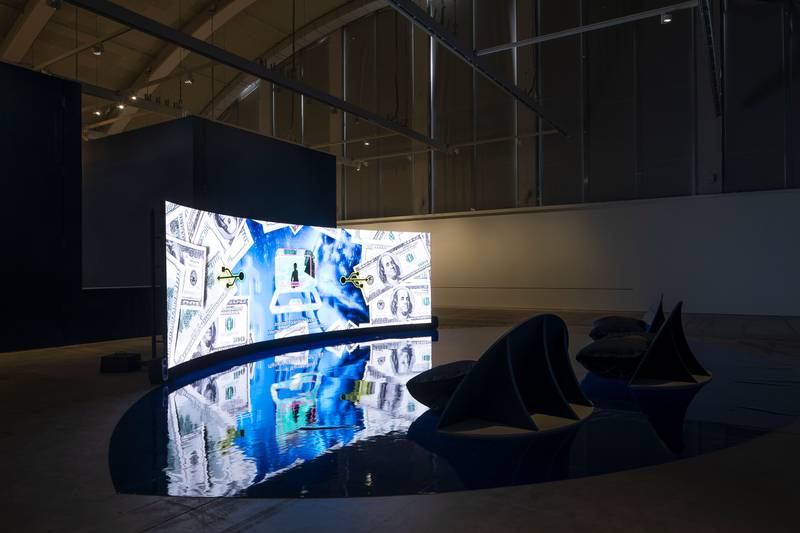

Tabita Rezaire: Deep Down Tidal, 2017. © HAM/Helsinki Biennial/Kirsi Halkola
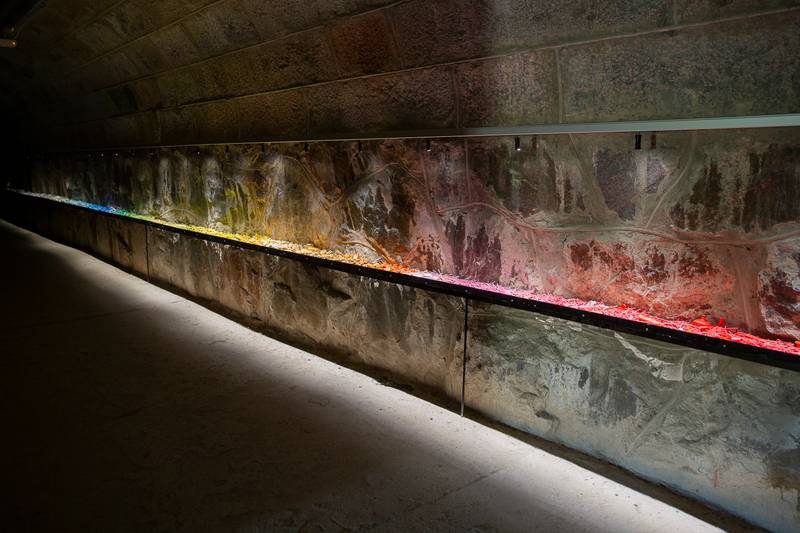

Tuula Närhinen, The Plastic Horizon, 2019-2023. © HAM/Helsinki Biennial/Sonja Hyytiäinen
Localities and Geopolitics
The paradox of biennials lies in their interconnected web or network, but do they genuinely learn from one another? Biennials often replicate each other’s practices, thematic questions, and approaches to commissioning new works. In many ways, my interest in writing this text has been centred around the title of the first edition of the Helsinki Biennial, “The Same Sea.”
In the Baltic Sea area and its vicinity, there have been nearly twenty different biennials over the past four decades. These include, for instance, the Turku Biennial (last held in its 8th Edition in 2018), the Luleå Biennial (last held in its 2nd Edition in 2020), the ARoS Triennial in Aarhus, Denmark (held only once so far in 2017), and the Göteborg International Biennial for Contemporary Art in Gothenburg (currently in its 12th edition, curated by João Laia this year. It still surprises me how little attention the themes of the Baltic Sea have received in these biennials and how infrequently they have sought to foster cooperation. It would have been natural to dialogue about what a biennial could be or to facilitate a transnational debate within the Baltoscandian context.
Nevertheless, there have been instances where the significance of locality and engagement with the local community has been acknowledged and has either benefited the community or left a lasting impact that extends beyond the actual duration of the biennials… If you were to ask the local community, many would desire to see more local artists, a variety of venues, or a new kind of articulation explaining why Vallisaari was chosen as the main venue for the biennial. The distinction between local and global is always more or less artificial, but like Rafal Niemojewski notes, biennials also produce narratives about themselves as an organization:
Some develop, over time, an entire rhetorical armature expressed and elaborated through a series of conferences, publications and exhibitions. Other facets of the narrative may remain latent but are often implicit and generally well understood. In order to fully assess this, it is necessary to examine the entire trajectory of biennial storytelling and its links to local metropolitan, regional or national histories. The institutional story of a biennial includes its founding narrative as well as an aggregate meaning constructed through its past, present and planned activities. (Niemojewski 2021.)
One example of how contemporary art biennials can benefit a locality, even outside the realm of art and from the Baltic Sea region, is the ‘Survival Kit’ in Riga, initiated in 2009. It has its roots in activism and was a response to the need to reclaim unused spaces, which was a significant issue in Riga’s urban planning at the time.
In Riga, there was also the Riga Biennial, also known as RIBOCA founded in 2018. The third edition of RIBOCA was canceled after a one-year postponement due to the Russo-Ukraine war. The primary reason for the cancellation was its Russian-based ownership and Russian-origin funding. RIBOCA aimed to protect participating artists from potential critique, but they faced criticism from the local scene as well. Some of this criticism was related to their attitude and their ability to rent or occupy sites in the Riga area (Uoti, 2023). This approach appears to be significantly different from the principles and values of the Survival Kit festival.
After critizing RIBOCA on the Latvian daily newspaper Delfi (6.6.2023), curator and author Maija Rudovska and art critic and art historian Santa Hirša requested in their statement on the online platform Blok Western Art Community to distance themselves from RIBOCA.
According to Hirša and Rudovska, Biennale represents a colonial mindset and rhetoric towards the art and cultural environment in Latvia (Hirša & Rudovska 2023).
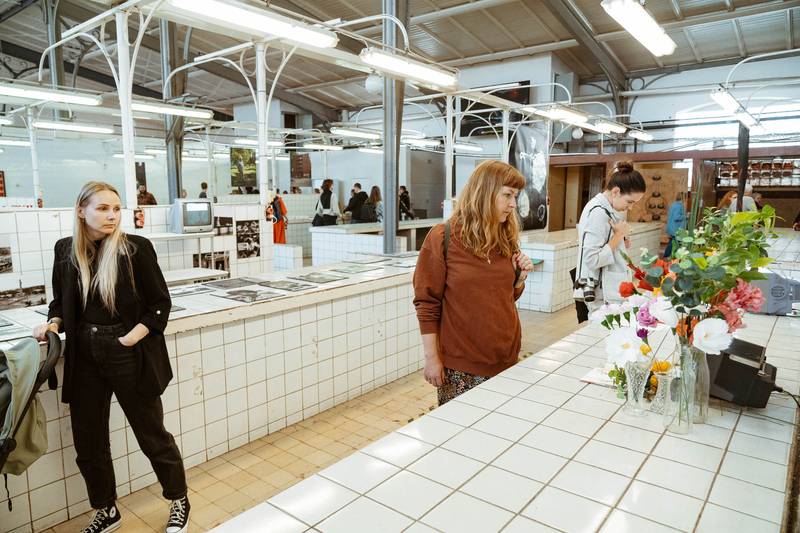

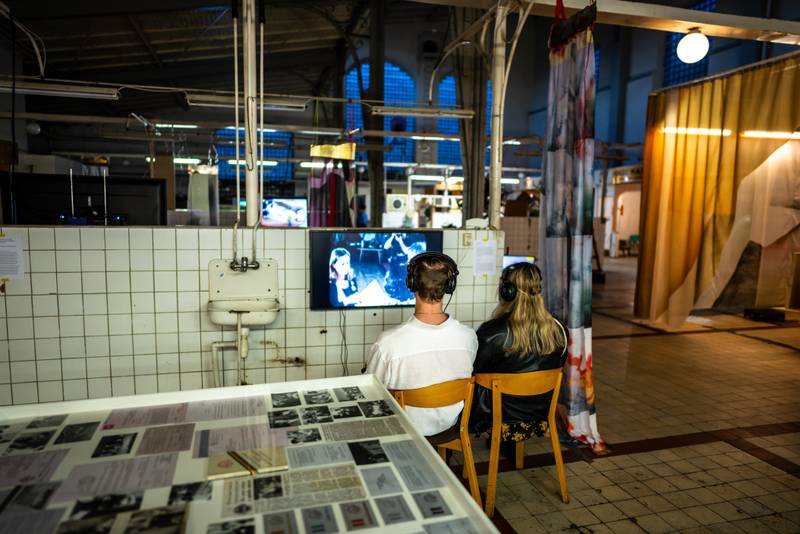

Visitors at the Contemporary Art Festival Survival Kit 14 “Long-distance Friendships” curated by Inga Lāce and Alicia Knock, in Riga, September 2023. Photo: Sanita Sparāne / Latvian Centre for Contemporary Art
Survival Kit’s latest edition also represented an interesting model of the cooperation between big-scale exhibitions. The 14th Edition of Survival Kit and the 14th Edition of Kaunas Biennial have created synchronicity with the same curators, Inga Lāce and Alicia Knock, and the common theme, “Long-distance Friendships”. Both exhibitions not only co-operated but also represented in an interesting way the question of cultural exchange during the Soviet Union and how the U.S.S.R. practised this in developing nations where cultural exchange was a tool for hybrid operations and spreading the ideology of Marxism–Leninism internationally.
When we think of globalization and different tendencies related to it, there are too often ahistorical interpretations of it and, for instance, what the role of biennials has been in it. The history and different models of cultural exchange in the context of festivals, seminars, panels, concerts, etc., should be further researched to understand the nuances of the possible conflicts, tensions, and connections that are especially distant from the homogenous neoliberal perspective of the present.
Biennials can be seen as modern-day world expositions, carrying historical significance. They have the potential to represent local issues for visitors and biennial tourists (compared with El Broul 2023) but also represent local issues from the outside for a wider audience in general. In HB23, for instance, Sepideh Rahaa’s work Songs to Earth, Songs to Seeds (2023), which focused on rice cultivation in Mazaarandan, North Iran, served as a powerful reminder of global interdependence and the diverse ways in which people lead their lives.


Sepideh Rahaa: Songs to Earth, Songs to Seeds, 2023. © HAM/Helsinki Biennial/Kirsi Halkola
But “locality” is also dependent on interpretations of history. When we talk about the sea, this should also be contemplated despite the global perspective of the biennials; otherwise, we’ll end up talking only about the history of capitalism and the neoliberal model of art production and what biennials more or less are. I think following Anders Härm biennials could also be a tool for understanding mutual history, mobility, cooperation and conflicts in a definite area. Härm has shown in relation to the almost forgotten Saaremaa Biennale, biennales might also be the tool for understanding history also as a discipline in the Post-Cold War context, which is also one way to connect with locality (Härm 2018).
The model of the Helsinki Biennial is unique because it is produced by the City of Helsinki. It is an almost cost-free biennial (for visitors) located in the beautiful archipelago of Helsinki. Within the context of Vallisaari, I appreciate how the biennial has made efforts to comprehend the site-specific nature of the island, considering its history and ecological aspects (Siitari & Tappola 2021, pp. 21–22). In the context of HB23, the question arises: Can biennials also contribute to regeneration rather than causing negative impacts related to tourism (Krysa 2023, 20)?
However, I believe that expanding the notion of locality beyond Vallisaari, encompassing the entire Helsinki archipelago and the Baltic Sea, could not only serve the biennial conceptually and its interests but also raise ecological awareness about the sea and the geopolitical conflicts, both past and present.
Is the question of a successful biennial related to how a biennial works conceptually, or does it show high-quality internationally significant artworks? How do biennial arguments justify its existence and meaning for locality? Should the storytelling and mediating of the biennials be based on realism or possible narratives, and if we talk about possible directions, do we fall on naïve idealism?
How We Look World(s) From a Biennial Site?
In a certain way, HB23 succeeded in its goal; it prompted a re-evaluation of the concept of a biennial. We can expect metaphoric friction between two different audience groups where this kind of conceptual and experimental biennial concepts are made.
The first group is made up of members who count themselves as a part of the “art world” as agents on the “web of biennials, art institutions and residences”. The second group is the group of “biennial tourists.” Is it possible to match the interests of the audience and art professionals together?
Is the question of a successful biennial related to how a biennial works conceptually, or does it show high-quality internationally significant artworks? How do biennial arguments justify its existence and meaning for locality? Should the storytelling and mediating of the biennials be based on realism or possible narratives, and if we talk about possible directions, do we fall on naïve idealism?
In the catalog of the first edition, Antti Salminen distinguished two ways of understanding a site, highlighting how they often exclude each other. If we view the world as a collection of sites, destruction constantly threatens this multiplicity. When a site has ‘its world,’ it implies the existence of parallel, nested, and untranslatable worlds—linguistic, experiential, or organic. These other ‘worlds’ are similarly at risk of perishing (Salminen, 2021, p. 24). Suppose we keep the artificial categorization between tourists and professionals. In that case, this raises the question of what kind of world they are living and experiencing and how they look at the world from the site.
Known for his analysis of fossil-driven capitalism, Salminen thinks the annoying task for art is to detach itself from the frame of humanism of fossil modernity (ibid. 25). For him, the possibility of site-specificity is the ability to locate with engagement in a significant way, which is also repeatable (ibid. 29). If I understand him right, we should perceive the continuity of the site from the “site”, which Salminen calls “a fractal promise of the site”. It is the question of how we can imagine an endless shoreline (ibid. 28–29). From the archipelago in our mind and understanding our incapability to complete taking of the line,
Biennials could work similarly. Remind us how it is impossible to understand the environment around us and keep our attention more focused on a specific moment than the list of artworks.
